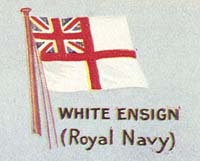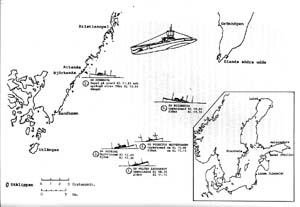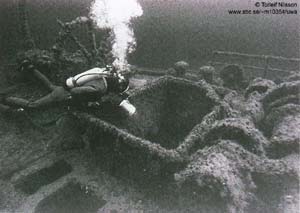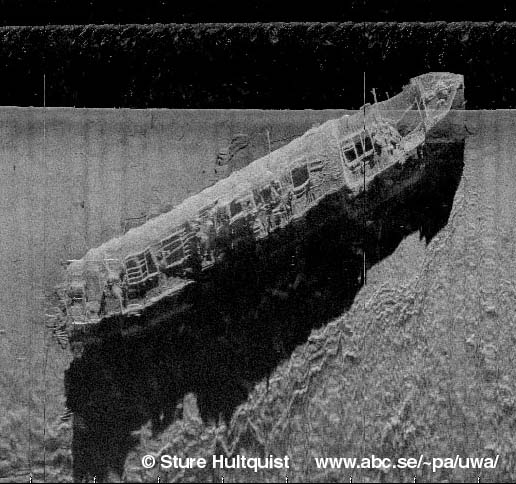The Submarine Massacre of 1915
During World War I, as well as during W.W.II, Swedish iron ore shipments were vital for Germany. Of course, the British Royal Navy did everything possible to disturb the shipments in the Baltic Sea.
 The
only entrance to the Baltic Sea consists of a few narrow, shallow passages in Danish waters and between
Denmark and Sweden. Posted near these passages, the German Navy watched for any British warships'
attempts to pass.
The
only entrance to the Baltic Sea consists of a few narrow, shallow passages in Danish waters and between
Denmark and Sweden. Posted near these passages, the German Navy watched for any British warships'
attempts to pass.
Finally, in September 1915, five British submarines successfully passed the Öresund strait into the Baltic Sea. These subs were then based in (allied) Russian naval ports until the Russian armistice and revolution in 1917. Their mission was to patrol the Baltic Sea and sink German ships, mainly shipments between Germany and neutral Sweden.
E-19 – Submarine Massacre
The most spectacular success was had by the E-19 during October 10 - 11, 1915. This sub was built in 1914 and commanded by Lieutenant-Commander Francis Cromie. On October 10, E-19 was patrolling south of the Swedish island Öland and spotted a German cargo steamer. The crew was made to abandon the steamer, but E-19 failed to sink it, due to rough weather.
The following morning, E-19 hailed the 75 m long German steamer S/S Walther Leonhardt, loaded with iron ore from Sweden. The crew was ordered to enter the life boat and approach the sub. Having examined the ship papers, commander Cromie had the steamer sunk by an explosive charge placed in the hold.
Later that morning, E-19 spotted a new target, the German S/S Germania, also carrying iron ore from Sweden. Having witnessed the sinking, Germania tried to escape. The E-19 chased the steamer at full surface speed, 15 knots, while firing the deck gun. After an hour, the steamer ran aground near the Swedish coast. The submarine crew placed a dynamite charge in the ship, but failed to sink her. The steamer was later salvaged and repaired.
The operations area in the south Baltic Sea
At 1 PM, E-19 spotted another German ship, the 100 m long S/S Gutrune, from Hamburg-Südamerikanische Dampfschiffahrts-Gesellschaft. Cromie ordered the ship to stop, and inspected the ship papers. After the crew was safely in the lifeboat, the ship was sunk by opening the bottom valves and circulation pumps. The ship sank slowly, but E-19 had to hurry towards another ship that had been spotted. This time it was a Swedish freighter headed for Holland, so it was allowed to pass.
Immediately afterwards, E19 stopped yet another German ship, the 80 m long S/S Director Reppenhagen, built in 1893, which was sunk in a similar manner.
At 5.30 PM, E-19 spotted the 120 m long S/S Nicomedia, built in 1901. After a short chase the German steamer stopped. During the inspection, the German crew gave a barrel of beer to the boarding party. But of course it was war, so finally the steamer was sunk.
On a single day the E-19 had sunk four ships and damaged one without using any torpedoes. Just a week later, British sub E-9 had a similar success off the Swedish east coast. The sinkings by E-19 were much later to be known as the "Submarine Massacre". However, for many years the whole story was forgotten.
Discovery
In 1982 a team of divers from Linköping, Sweden, searched a spot indicated by fishermen. They soon discovered a large wreck on about 35 m depth. The divers reported that the very well preserved wreck was standing upright on the flat sea bottom. Thanks to the ship bell, the wreck was identified as the S/S Nicomedia. This resulted in archive research, which revealed the whole story.
Near the stern of Walter Leonhardt
During the summers of 1983-84 all the remaining wrecks were located by Sten Lindgren, Torleif Nilsson, Lars-Åke Jacobsson, Göran Smith and Jan Hector.
Several of the wrecks' interiors were extremely well preserved. Cabin doors and furniture were still in place. Curtains were still hanging and other textiles were preserved as well. Inside Director Reppenhagen, mirrors were still hanging on the walls. The wrecks were documented by photo and in 1985 they were videofilmed. There was also correspondence with Mr Ben Benson, the last surviving member of E-19's crew, who died shortly afterwards in 1985.
Now, 15 years after the initial investigation, some of the deck structures have started to collapse under their own weight. This is probably due to rusting after nearly a century. This is typical of the Baltic Sea, where iron rusts gradually, but organic matter can be preserved for centuries.
sonogram of Nicomedia by Sture Hultquist
Wreck Beer
In 1999, some beer bottles from Nicomedia were recovered. Perhaps this was the same beer that was offered to E-19. The yeast in the bottles was still alive after all these years. It was re-cultivated by Slottskällans bryggeri, a Swedish brewery, in 2000 and is now sold as the "Wreck Beer". Having tasted it, I can affirm that it tastes very good indeed.
Per Åkesson, August 1998
Related texts
- The sinkings of E-9
- Development of the submarine
- Projekt ölbärgning 1999, Mats Karlsson (in Swedish)
Related link
- WW1 British Submarines (sometimes bad connection)
Literature
- Torleif Nilsson: Ubåtsattack i södra Kalmarsund 1915 (Föreningen Marinmusei vänner, Karlskrona 1989). This book contains a detailed report with several good illustrations. If it's not sold out, it can be purchased from the Swedish Naval Museum.
- Claes-Göran Wetterholm: Vrak i svenska vatten (1994)
- Per-Olof Ekman: Havsvargar (Schildts, 1983)
Film
"Havets skuggor", Swedish Television, 1986. Spectacular film from the wrecks, available on YouTube.



 Back to Nordic Underwater Archaeology
Back to Nordic Underwater Archaeology